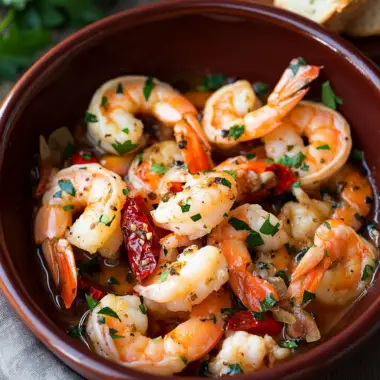Slow-roasted rhubarb is a refined yet incredibly simple way to highlight the naturally tart and vibrant nature of rhubarb. By gently roasting it with orange juice, zest, sugar, and fragrant vanilla, this recipe coaxes out the fruit’s juiciness while mellowing its tang. The low-and-slow method preserves the rhubarb’s structure, so it emerges meltingly tender but not mushy perfect for spooning over yogurt, ice cream, pancakes, or even enjoying straight from the dish. This elegant preparation lets seasonal produce shine and is easy enough for weekday cooking but stunning enough for entertaining. It’s a beautiful example of how a handful of quality ingredients and a little patience can create something truly special. The orange and vanilla elevate the rhubarb without overwhelming it, creating a deeply aromatic syrup that adds both flavor and visual appeal. Serve it warm or chilled; either way, this slow-roasted rhubarb brings a bit of sunshine to your table.
Full Recipe:
Ingredients:
-
1 lb rhubarb, trimmed and cut into 4-inch lengths
-
3/4 cup granulated sugar
-
Zest of 1 orange
-
Juice of 1 orange
-
1 vanilla bean, halved lengthwise
-
Pinch of salt
Directions:
-
Preheat the oven to 275°F (135°C).
-
In a baking dish, combine the rhubarb pieces with sugar, orange zest, orange juice, salt, and the seeds scraped from the vanilla bean (along with the pod).
-
Gently toss everything together and arrange the rhubarb in a single layer.
-
Cover the dish tightly with foil and bake for 50–60 minutes, until the rhubarb is tender but still holds its shape.
-
Let it cool in the syrup, then remove the vanilla pod and serve warm, chilled, or at room temperature.
Prep Time: 10 minutes | Cooking Time: 60 minutes | Total Time: 1 hour 10 minutes
Kcal: 120 kcal | Servings: 4 servings
Slow-Roasted Rhubarb with Citrus and Vanilla: A Simple Yet Elegant Seasonal Delight
Few ingredients capture the essence of spring quite like rhubarb. Its vibrant pink stalks and tart flavor make it a unique and cherished ingredient, especially when it’s showcased in recipes that allow its natural qualities to shine. One such preparation that has gained popularity among food lovers, home cooks, and culinary creatives is slow-roasted rhubarb with citrus and vanilla. This dish highlights rhubarb’s bright flavor while balancing it with the warmth of vanilla and the sunny notes of orange. The result is a luscious, tender treat that’s as versatile as it is stunning.
In this article, we’ll explore everything that makes this dish special: its roots in seasonal cooking, the beauty of minimalism in recipe design, the flavor profile it creates, ideal pairings and serving ideas, variations, and why it deserves a spot in your kitchen year after year.
A Tribute to Rhubarb Season
Rhubarb season is fleeting, typically running from early spring through the first part of summer. For a few precious months, farmers’ markets and grocery stores are awash in bundles of rosy stalks that range in color from pale green to deep ruby red. Although technically a vegetable, rhubarb is often treated like a fruit in culinary applications. Its tartness demands the addition of sweeteners or complementary flavors to bring out its potential.
Slow-roasting rhubarb is one of the gentlest and most flavorful ways to prepare it. Rather than boiling or stewing the stalks methods that can easily turn them into mush roasting at a low temperature helps maintain their structure while softening the fibers just enough to make them silky and luxurious. Combined with fresh orange juice, zest, a bit of sugar, and the aromatic touch of vanilla, the result is a dish that feels sophisticated yet effortless.
A Flavor Profile Worth Savoring
The true genius of this recipe lies in the interplay between the ingredients. Rhubarb’s sharp tang is mellowed but not erased by the slow roasting process and the addition of sugar. The orange juice and zest infuse the dish with a brightness that amplifies rhubarb’s natural tartness while introducing a floral citrus aroma. Vanilla adds a warming, deep complexity that balances the overall acidity and gives the syrup a perfumed elegance.
What you end up with is a contrast of textures and tastes tender rhubarb pieces that retain their shape, swimming in a golden, syrupy reduction that smells like springtime in a jar. The vibrant pink and amber hues make this dish as beautiful as it is flavorful, perfect for any table or gathering.
Simplicity That Elevates
One of the standout features of this slow-roasted rhubarb recipe is its simplicity. With just a handful of ingredients and minimal preparation, it allows you to fully appreciate the purity of fresh produce and thoughtfully chosen flavors. This is a recipe rooted in restraint, proving that you don’t need complexity to create something memorable.
This minimalist approach is perfect for those who love cooking but also value ease and efficiency in the kitchen. It’s equally suited to novice cooks who want a forgiving, high-impact dish and to seasoned chefs who understand the value of elevating seasonal ingredients without overworking them.
Serving Suggestions and Pairings
Slow-roasted rhubarb is incredibly versatile. While it can certainly be enjoyed on its own perhaps chilled and served as a light dessert it truly shines when used as a topping or accompaniment to other dishes. Here are some delicious ways to use it:
-
Yogurt Parfaits: Layer the rhubarb with Greek yogurt and granola for a breakfast that feels like dessert.
-
Ice Cream Topping: Spoon the warm rhubarb and syrup over vanilla or coconut ice cream for an indulgent treat.
-
Pancakes and Waffles: Add a spoonful on top of your weekend breakfast favorites to brighten things up.
-
Pound Cake or Shortcake: Pair with whipped cream and a simple sponge for a refreshing twist on strawberry shortcake.
-
Cocktails or Mocktails: Use the syrup in sparkling water, lemonade, or cocktails for a unique, fruity flavor enhancer.
-
Cheese Board Companion: The tart-sweet balance complements creamy cheeses like goat cheese or brie beautifully.
Its adaptability means you can use it across meals from brunch and afternoon snacks to elegant desserts and even cocktails.
Variations and Customizations
Once you’ve mastered the base recipe, you can easily experiment with variations. Here are a few ideas to inspire your next batch:
-
Switch the Citrus: Try lemon, grapefruit, or blood orange instead of standard orange for a new dimension of flavor.
-
Spice It Up: Add cardamom pods, cinnamon sticks, or star anise for added warmth and complexity.
-
Sweetener Options: Swap out granulated sugar for honey, maple syrup, or agave nectar to add depth and personalize the taste.
-
Add Berries: Include a handful of strawberries or raspberries for a mixed-fruit version with more visual and textural variety.
-
Make It Boozy: Add a splash of Grand Marnier, Cointreau, or rose liqueur for a sophisticated adult twist.
These customizations allow the dish to evolve with your mood, guests, or seasonal ingredients on hand.
Nutritional Benefits
Rhubarb is surprisingly nutritious. It’s low in calories and contains fiber, vitamin K, calcium, and antioxidants. While it’s often sweetened in cooking, the overall sugar content can be moderated based on personal preference or dietary needs. Because this dish uses fruit juice and natural vanilla, you can get away with using less sugar than you might in a jam or pie filling.
Choosing to roast rather than stew or boil the rhubarb also means fewer nutrients are lost in the cooking process, and you’re left with a finished product that feels light, clean, and wholesome.
Sustainability and Seasonality
Eating seasonally isn’t just about flavor it’s also about sustainability. Using ingredients at their peak ensures you’re getting the best taste and nutritional value while supporting local agriculture. Rhubarb is one of those ingredients that shines brightest during its short window of availability, and this recipe is a great way to preserve that peak flavor without overwhelming it with extra processes or heavy fats.
This dish also stores well. The roasted rhubarb can be kept in the fridge for up to a week, and the syrup can even be frozen or used to make rhubarb-inspired drinks or sauces later on. It’s a smart way to extend the life of a seasonal treat.
Why This Recipe Belongs in Your Rotation
In the world of seasonal desserts and simple cooking, few recipes strike the balance that slow-roasted rhubarb does. It’s visually stunning, deeply flavorful, easy to prepare, and incredibly adaptable. Whether you’re cooking for yourself, entertaining guests, or looking for a fresh take on fruit-based desserts, this dish offers both elegance and ease.
The minimal ingredient list also makes it cost-effective. You can prepare it quickly without specialty equipment or complicated techniques, and it scales beautifully for larger servings.
Conclusion:
Slow-roasted rhubarb with citrus and vanilla is more than just a dish it’s a celebration of seasonality, simplicity, and the power of letting ingredients speak for themselves. With just a few carefully chosen components, it transforms a humble stalk into something worthy of your best china or most casual Sunday brunch.
Whether you’re a longtime fan of rhubarb or discovering it for the first time, this preparation is an invitation to slow down, savor, and indulge in the natural rhythms of the season. It’s a reminder that in cooking, as in life, sometimes the simplest things are the most satisfying.








